Choisir les bonnes encres de sérigraphie peut faire toute la différence dans le résultat de vos créations.. Ces encres sont spécialement conçues pour donner de la luminosité, impressions durables sur toutes sortes de surfaces.
Que vous travailliez avec des vêtements, accessoires, ou des signes, Comprendre les types d'encres est essentiel pour obtenir d'excellents résultats..

Dans ce guide, nous aborderons les bases des encres de sérigraphie, expliquer leurs différentes utilisations, et vous aider à décider quelle encre convient le mieux à votre projet spécifique.
Explorons comment la bonne encre peut donner vie à vos créations!
Guide des encres de sérigraphie: Tout ce que vous devez savoir
Comprendre l'encre de sérigraphie
Il s'agit d'un type spécial d'encre utilisé dans le processus de impression d'écran pour transférer des motifs sur divers matériaux comme le tissu, papier, ou en métal. Cette encre est plus épaisse que l'encre d'impression ordinaire, lui permettant de créer des impressions vibrantes et durables qui peuvent résister au lavage et à la manipulation.
Types courants d’encres de sérigraphie
Il existe différents types d'encres d'imprimerie, chacun offrant des qualités et des finitions uniques, il est donc important de choisir celui qui convient en fonction des besoins de votre projet et du type de tissu.
- Encre Plastisol
- Encre à base d'eau
- Décharge d'encre
- Encre pour écran en aluminium
- Encre métallique
1. Encre Plastisol
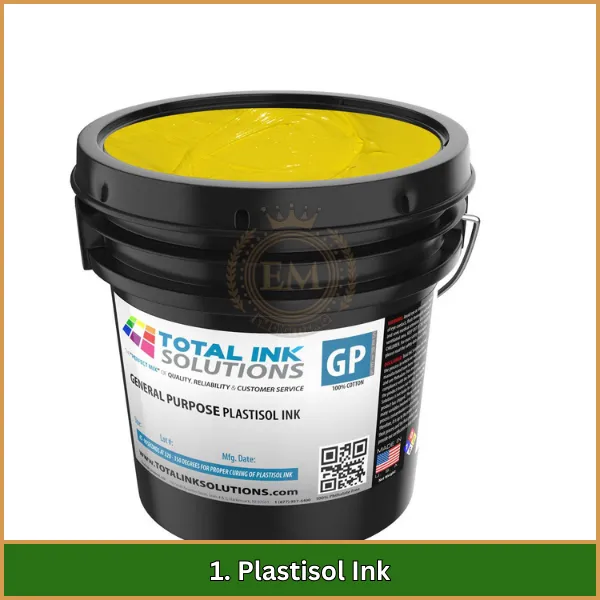
Le Plastisol est l'encre de sérigraphie la plus couramment utilisée dans l'industrie.. C'est épais, durable, et idéal pour imprimer sur divers tissus. L'encre Plastisol reste à la surface du tissu, fournissant des impressions vibrantes et durables. This type of ink is widely used because it doesn’;ne sèche pas sur l'écran, ce qui facilite le travail sur de longues périodes.
Avantages:
- Des couleurs vibrantes: Les encres Plastisol produisent des couleurs vives, des imprimés audacieux qui se démarquent.
- Durabilité: Les impressions durent plus longtemps et sont très résistantes à la décoloration, fissuration, ou pelage.
- Facilité d'utilisation: Cette encre est conviviale et ne sèche pas rapidement, permettre plus de temps pour travailler.
Les inconvénients:
- Non respirant: Plastisol can feel heavy on the fabric and doesn’;ne laisse pas passer beaucoup d’air.
- Préoccupations environnementales: Puisqu'il est fabriqué en PVC, it’;n'est pas aussi écologique que certains autres types d'encres.
2. Encre à base d'eau
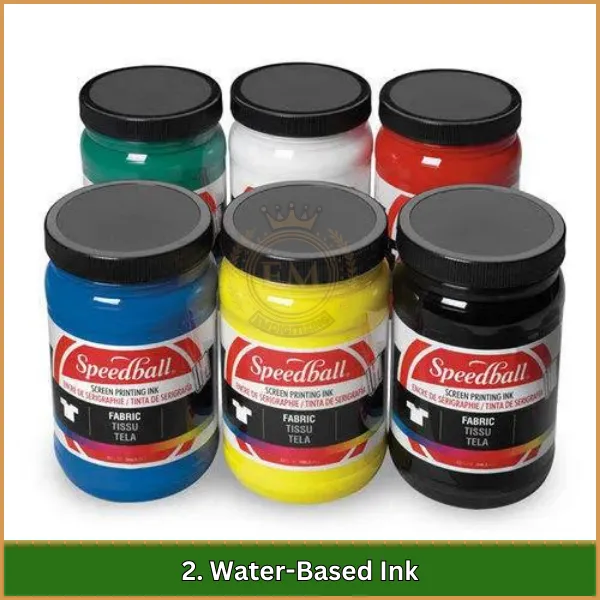
L'encre à base d'eau utilise l'eau comme solvant principal au lieu de produits chimiques, ce qui en fait une option plus écologique. Ce type d'encres de sérigraphie pénètre dans le tissu plutôt que de rester dessus., résultant en une finition plus douce. Ils sont parfaits pour obtenir un look naturel, surtout sur les tissus légers.
Avantages:
- Toucher doux: Les encres à base d'eau pénètrent dans le tissu, laissant une impression légère et douce.
- Respectueux de la nature: Ils contiennent moins de produits chimiques nocifs et sont plus sûrs pour l'environnement que le plastisol..
- Idéal pour les tissus légers: Ces encres fonctionnent mieux sur les matériaux de couleur claire et offrent un résultat propre., finition lisse.
Les inconvénients:
- Limité sur les tissus foncés: Water-based inks don’;n'apparaît pas également sur les tissus foncés à moins d'être mélangé avec des additifs spéciaux.
- Séchage rapide: Ils ont tendance à sécher rapidement sur l'écran, ce qui peut les rendre difficiles à utiliser pour des conceptions détaillées ou volumineuses.
3. Décharge d'encre
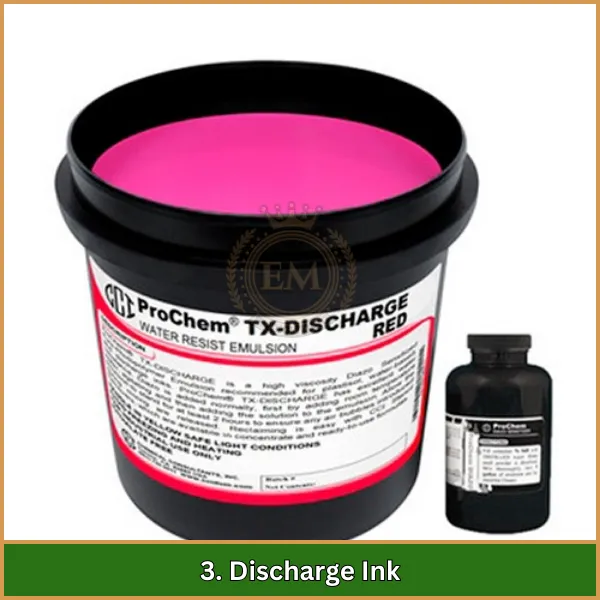
Cela fonctionne différemment de la sérigraphie à l’encre traditionnelle. Au lieu d'ajouter de la couleur au tissu, il supprime le colorant existant et le remplace par une nouvelle couleur. Cela rend l'encre à décharge parfaite pour imprimer des motifs clairs sur des tissus foncés., donnant l'apparence des meilleures encres de sérigraphie sans superposer trop d'encre.
Avantages:
- Finition douce: Comme les encres à base d'eau, l'encre de décharge entraîne un doux, imprimé respirant.
- Des couleurs vives sur des tissus foncés: Il offre une dynamique, couleur d'apparence naturelle sur des matériaux sombres sans ajouter de lourdes couches d'encre.
Les inconvénients:
- Processus complexe: L'impression par décharge nécessite plus d'expertise et peut être plus difficile à contrôler.
- Odeur chimique: Ce type d'encre peut produire une forte odeur pendant le processus d'impression.
4. Sérigraphie sur feuille
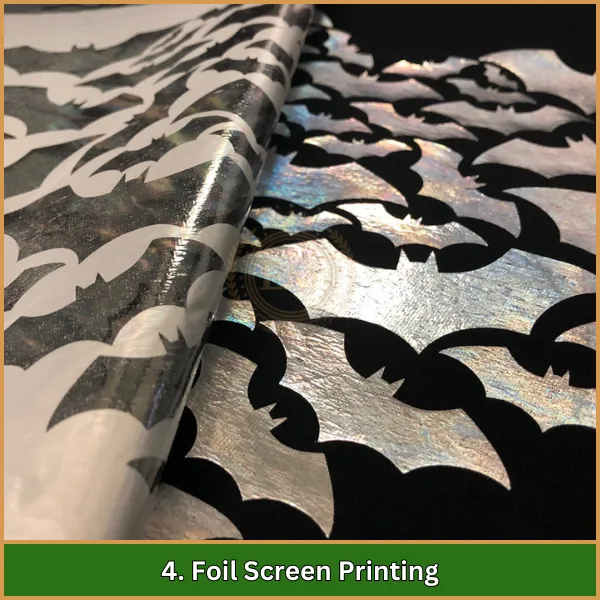
La sérigraphie ajoute un aspect métallique brillant aux vêtements en utilisant une fine feuille de papier d'aluminium.. Le processus commence par l'impression d'un adhésif sur le tissu, puis par l'application du film sur l'adhésif.. Le résultat est une réflexion, finition brillante qui donne au design un aspect luxueux.
Avantages:
- Finition brillante: L'impression sur feuille offre un effet saisissant, look métallique qui se démarque, ce qui le rend parfait pour les conceptions spéciales.
- Apparence unique: Cela ajoute un caractère unique, finition haut de gamme des produits, les rendant plus attractifs.
Les inconvénients:
- Moins résistant: Les impressions sur film peuvent se fissurer ou se décoller avec le temps, surtout avec des lavages ou des vêtements fréquents.
- Coût plus élevé: C'est un processus plus coûteux que les encres de sérigraphie traditionnelles..
5. Encre métallique

L'encre métallique est obtenue en mélangeant de petites particules métalliques avec de l'encre standard., en lui donnant une réflexion, aspect brillant. Cette meilleure encre de sérigraphie est couramment utilisée pour créer des effets spéciaux ou des impressions décoratives qui doivent se démarquer.
Avantages:
- Aspect brillant: L'encre métallique ajoute une touche brillante, éclat réfléchissant qui rend les designs accrocheurs.
- Durabilité: Les imprimés métalliques ont tendance à durer plus longtemps et à conserver leur aspect éclatant.
Les inconvénients:
- Encre plus épaisse: Les particules métalliques rendent l'encre plus épaisse, ce qui peut conduire à une texture plus rugueuse sur le tissu.
Utilisation limitée: L'encre métallique ne fonctionne pas bien avec tous les types de tissus et peut nécessiter des techniques d'application spécifiques..
Facteurs à prendre en compte lors du choix des encres de sérigraphie adaptées à votre projet
Choisir la bonne encre pour la sérigraphie implique de comprendre plusieurs facteurs clés pour vous assurer d'obtenir les meilleurs résultats pour votre projet.. Voici les aspects importants à considérer:
1. Type de substrat
Le type de matériau sur lequel vous imprimez joue un rôle important dans la sélection de l'encre appropriée.. L'encre de sérigraphie sur tissu comme Plastisol fonctionne bien sur le coton et le polyester, tandis que les encres à base d'eau sont idéales pour les fibres naturelles telles que le coton et la soie..
2. Exigences de conception
- Éclat des couleurs: Pour des couleurs vives, les encres à base d'eau sont idéales pour une finition éclatante. Pour les tissus plus foncés, Les encres Plastisol offrent une meilleure couverture et opacité.
- Niveau de détail: Si votre conception comporte des détails complexes, les encres spéciales comme les encres métalliques ou feuilletées peuvent nécessiter des techniques et des tailles de maillage spécifiques pour de meilleurs résultats.
3. Méthode de durcissement
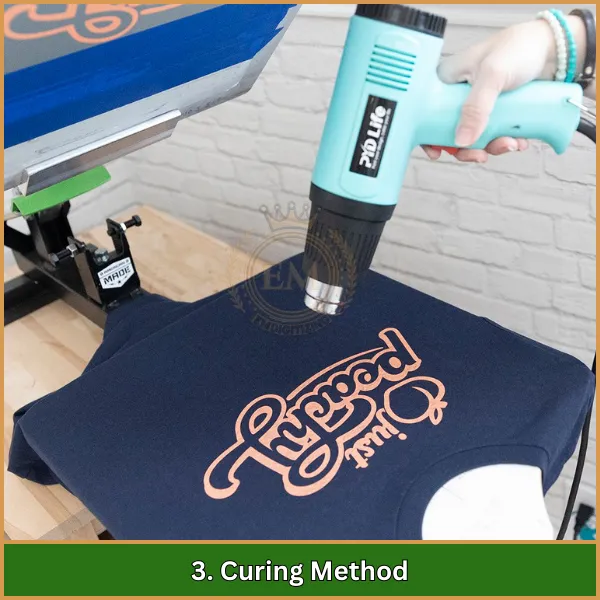
Différentes encres nécessitent différentes méthodes de durcissement. Les encres Plastisol durcissent à des températures plus basses, ce qui les rend adaptés aux matériaux sensibles à la chaleur.
Encres à base d'eau, d'autre part, nécessitent souvent des températures plus élevées et des temps de durcissement plus longs.
4. Durabilité et longévité
Lors du choix de l'encre, considérez combien de temps l’impression doit durer. Recherchez des encres résistantes aux rayons UV, humidité, et porter, surtout si l'article sera exposé aux éléments.
5. Considérations environnementales
Si la durabilité est importante, sélectionner des encres contenant peu de composés organiques volatils (COV) ou des formulations respectueuses de l'environnement pour répondre aux réglementations environnementales et réduire votre empreinte carbone.
6. Rentabilité
Tenez compte non seulement du prix de l’encre, mais également de son efficacité.. Certaines encres peuvent avoir un coût initial plus élevé, mais permettront d'économiser de l'argent à long terme grâce à une consommation moindre ou à une réduction des déchets..
7. Cohérence des couleurs

Assurez-vous que l'encre fournit une couleur cohérente tout au long des tirages d'impression.. Effectuez des tests de correspondance des couleurs pour vous assurer que l'encre fonctionne bien avec votre système de gestion des couleurs et obtenir des résultats précis.
Quelles sont les applications de la sérigraphie dans différentes industries?
La sérigraphie est largement utilisée dans diverses industries en raison de sa polyvalence et de sa capacité à produire des impressions de haute qualité.. Voici les applications clés dans différents secteurs:
1. Industrie du vêtement

- T-shirts et vêtements: La sérigraphie est couramment utilisée pour personnaliser les t-shirts, sweats à capuche, et autres vêtements. Les encres Plastisol sont populaires pour leur durabilité et leurs couleurs éclatantes, ce qui les rend parfaits pour les vêtements fréquemment lavés et portés.
- Vêtements promotionnels: Les entreprises utilisent la sérigraphie pour les vêtements de marque comme les uniformes et les cadeaux, car l'encre garantit des designs attrayants et durables..
2. Accessoires textiles
- Sacs et casquettes: La sérigraphie est utilisée sur des accessoires tels que des sacs fourre-tout, casquettes, et des chaussettes, fournir une qualité constante sur différents matériaux.
3. Publicité et marketing
- Bannières et signalisation: La sérigraphie est utilisée pour créer des bannières vibrantes, drapeaux, et signalétique pour événements. La durabilité des encres plastisol les rend idéales pour une utilisation en extérieur.
- Présentoirs de point de vente: Les détaillants utilisent la sérigraphie pour créer des présentoirs attrayants qui attirent l'attention des clients et font la promotion des produits..
4. Décoration de maison

Textiles: La sérigraphie est appliquée aux textiles de maison comme les rideaux, coussins, et nappes, permettant conceptions personnalisées qui embellissent les intérieurs de la maison.
5. Applications industrielles
- Vêtements de sécurité: Des encres fonctionnelles spéciales sont utilisées dans les vêtements de sécurité pour garantir une haute visibilité et répondre aux normes de sécurité., souvent avec des propriétés réfléchissantes.
- Étiquettes de produits: La sérigraphie est utilisée pour créer des étiquettes durables sur des produits industriels pouvant résister à des conditions difficiles..
6. Produits spécialisés
- Vêtements de sport: Des encres spécialisées sont utilisées sur les vêtements de sport pour offrir flexibilité et respirabilité tout en conservant leur éclat., couleurs durables.
- Articles promotionnels: Les encres sont appliquées sur des objets comme des stylos, porte-clés, et tapis de souris à des fins de branding et de marketing.
7. Conditionnement
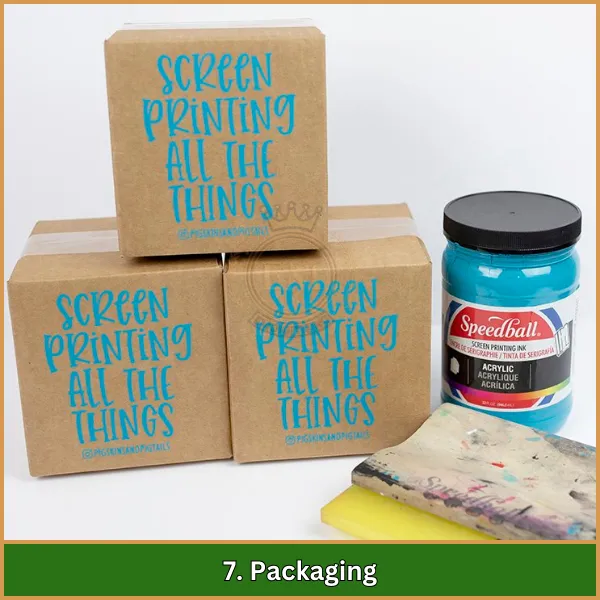
- Emballage alimentaire: Des encres spéciales sont formulées pour les matériaux d'emballage, s'assurer qu'ils sont sans danger pour le contact alimentaire tout en conservant impressions de haute qualité.
Conclusion
En résumé, sélectionner les bonnes encres de sérigraphie est essentiel pour produire des produits de haute qualité, impressions durables. En connaissant les différents types d’encres et leurs applications, vous pouvez vous assurer que vos créations sont éclatantes, clair, et professionnel sur tout matériel. Le bon choix d'encre fera une grande différence dans l'apparence générale et la durabilité de vos impressions..
Pour rendre vos créations encore plus précises et prêtes pour la sérigraphie, EMnumérisation propose des services experts en art vectoriel. Notre équipe veille à ce que vos illustrations soient parfaitement préparées pour des résultats d'impression nets et détaillés.. Plus, en tant que premier client, vous pouvez profiter d'un 50% réduction sur notre services d'art vectoriel. Profitez de cette offre exceptionnelle pour agrémenter vos projets d'impression avec des designs de qualité supérieure!
FAQ
Pour nettoyer l'encre d'un écran de sérigraphie, gratter l'excédent d'encre, utilisez ensuite un nettoyant pour écran ou un dissolvant d'émulsion conçu pour la sérigraphie. Rincez-le bien à l'eau pour éliminer tout reste d'encre.
Oui, vous pouvez utiliser de l'encre d'imprimerie pour l'impression en bloc, mais son épaisseur et son temps de séchage peuvent être différents des encres d'impression en bloc ordinaires, ce qui pourrait affecter la qualité de l'impression.
Oui, vous pouvez superposer de l'encre de sérigraphie en appliquant différentes couleurs en passes séparées. Assurez-vous que chaque couche sèche complètement avant d'ajouter la suivante pour éviter le mélange des couleurs..
Oui, tu peux peindre avec de l'encre d'imprimerie, mais il est spécialement conçu pour la sérigraphie, donc cela peut ne pas fonctionner comme les peintures traditionnelles sur différentes surfaces.
